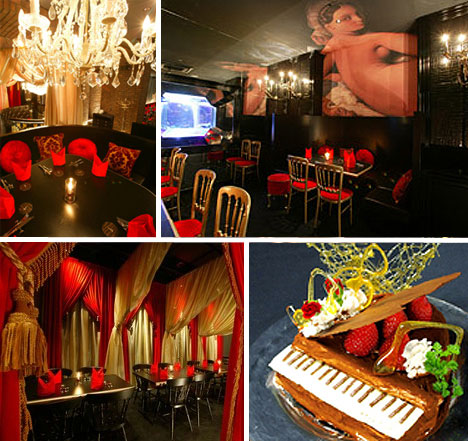Theming
The word theme means ‘’the element common to all or most of the forms of an inflectional paradigm, often consisting of a root with certain formative elements or modifications.’’ In this context it simply means that an institution or object is clothed in narrative that is largely unrelated to which it is applied. It is interesting to note that Walt Disney hit upon the principles of theming as a device for differentiating his vision from the tawdry and grimy amusement parks to which he had taken his daughters. He felt that it should be possible to create an environment which adults would be just as keen to visit as children.
If you do a good search on the restaurants in Japan, you will come across quite a number of themed ones. Some examples are:
· The Wizard of the Opera
Worth it for the name alone, this restaurant promises "gorgeous and gothic dining", but what they really mean is that it's opera-themed. The sauces are drawn on like musical notation, they make a delicious smoked-salmon dish ingeniously (no, really) shaped like a rose, and they'll even squirt out the word "opera" for you in cursive chocolate. The tables are made of marble and the music is – duh – opera.
The quality of the cuisine doesn't measure up to the Wizard's high-culture aesthetic, being largely manufactured at the same facility that serves the dozens of other restaurants owned by the Diamond Dining group, but if your date complains just put an admonishing finger to their lips and then use that finger to indicate the Donizetti.
· Princess Heart
Princess Heart plays straight to the frilly delusion of many a young lady, promising to transform you into a monstrous Disneyfied conflation of Cinderella, Snow White and Sleeping Beauty. It's a magical fantasy land on the fifth floor of an office building in Ginza, the city's very-expensive-pen district. The elevator doors open to a smiling manservant who addresses you using honorific Japanese usually reserved for royalty. Then he shows you to a full-length mirror in which, apparently, you are expected to preen. Then inside is a magical forest with a giant wizard's tree and heart-shaped chairs. The desserts are shaped variously like hearts, clocks, hearts and hearts.
Try "Salad Rolls of Shrimp and Steam Chicken with Two Sauces Enchanted with Sleeping Beauty's Voice", or "Something Cinderella Leaf-Baked Custard of Magic at 12 O'Clock". Just make sure you leave before the dwarves kiss you at midnight, or whatever.
· Namahage
For good luck, some people rub rabbits' feet. In the northern prefecture of Akita, on the other hand, they dress as demons, striking fear into the hearts of young children and making them cry. If you're thinking, "sounds like a brilliant idea for a family restaurant," too bad - Namahage's beaten you to it. While you're eating your meal (your standard nabe soups and fried chicken, loosely based on traditional Akita cooking), the lights suddenly cut out, and a deafening wailing fills the air. Stamping and shouting in the semi-darkness, performers dressed as giant "namahage" evil spirits go from table to table, as they are said to go from house to house in Akita, asking: "Any bad guys, or lazy guys?''
To demonstrate your innocence, so that the Namahage will offer a blessing rather than take you back to the mountains for eternity, you're expected to feign surprise or even fear – though the performance is entertainingly jarring enough that you won't have to fake it. It's like a meal and a traumatizing character test in one. It is surprisingly popular with families.
As one can see from these examples, the simple act of eating can be elevated to become a complex experience because of themes. Diners are surrounded by vivid images and sounds that play a part in the theme. Some restaurants are popular because of their themes and not their food.
Even shops are not from spared from ‘’Disnifycation’’. An example is the coffee shops- Maid Kissa.
They are the coffee shops where the waitresses where the waitress dresses up like fantasy-like maid costumes that resemble characters from famous Japanese comics.
As the customer enters the premise he or she is greeted by an alluring “welcome home my master”. In addition to the verbal role play offered, maids pour coffee and tea for patrons, or engage in a game of cards upon request. Many of these coffee shops are decorated in the style of an English Mansion to simulate feelings of truly being “master of the house”. Some shops are subtly veering from the coffee shop image by referring to their place of business as cafes, often reflecting the owners’ personal taste in interior design and music, and emphasizing a European atmosphere where home-style food and a great cup of coffee can still be enjoyed.
Since Akihabara caters not only to electronic enthusiasts but also young Japanese otaku which translates roughly to nerd in English. On Sundays down Chuo-Dori, the main street in Akihabara you can find the "maids" passing out pamphlets to their shops to passersby.
Sources:
http://dictionary.reference.com/browse/theme
http://www.guardian.co.uk/travel/2008/nov/27/tokyo-theme-restaurants-japan-food
http://www.coffeedome.com/503/the-coffee-shops-of-japan/
http://www.dawsons.com.au/MeetingServicesEd46/images/CreativeTheming3.jpg
http://img.weburbanist.com/wp-content/uploads/2009/08/wizard-of-the-opera.jpg
http://news.3yen.com/wp-content/images/princess_birtday.jpg
http://lh4.ggpht.com/_uG2jT-2AtxI/SJAXEV06jQI/AAAAAAAAFo4/aYVsiUaPfZw/IMG_0915.JPG
http://toybox.typepad.com/.a/6a00e54f80ae3e883300e553de570b8833-400wi



No comments:
Post a Comment